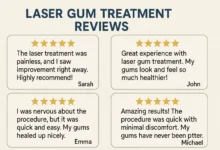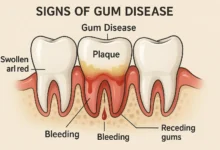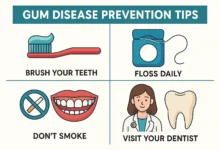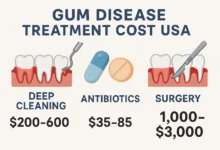Early Signs of Gum Disease: Recognize the Warning Signs Before It’s Too Late
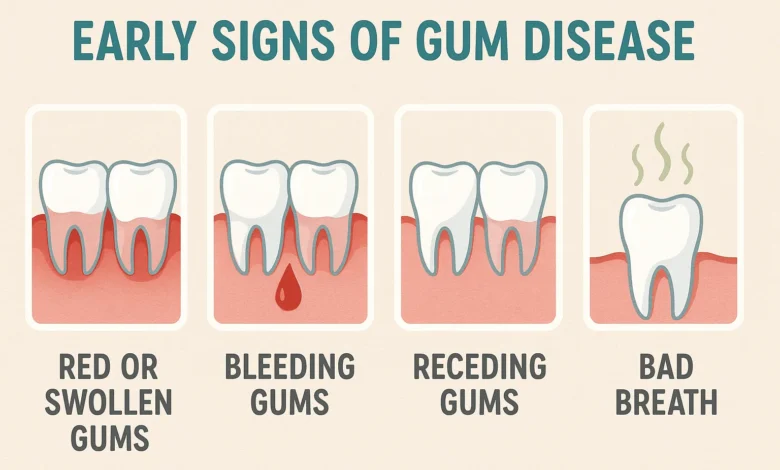
Early Signs of Gum Disease: Your 2025 Guide to Identification, Treatment, and Prevention
Did you know that almost half of the adult population (30 years and above) has gum disease in some form? The CDC reveals that it is one of the most prevalent chronic conditions in the world. But at its earliest beginning it is practically undoable. It is not a non-problem or the failure to be concerned, it is simply a failure to recognize.
The symptoms of gum disease are commonly very delicate and may be overlooked or confused with others at a very early stage. This is the ultimate guide that you need. We will bust the myth of what to check, we will have clear pictures of early signs of gum disease and we will describe the precise steps one needs to follow to take charge of his or her oral health. Learning the onset symptoms of gum disease, you will be able to prevent it at an early stage and save the smile on your face and your health in general.
What is Gum Disease? Understanding the Enemy
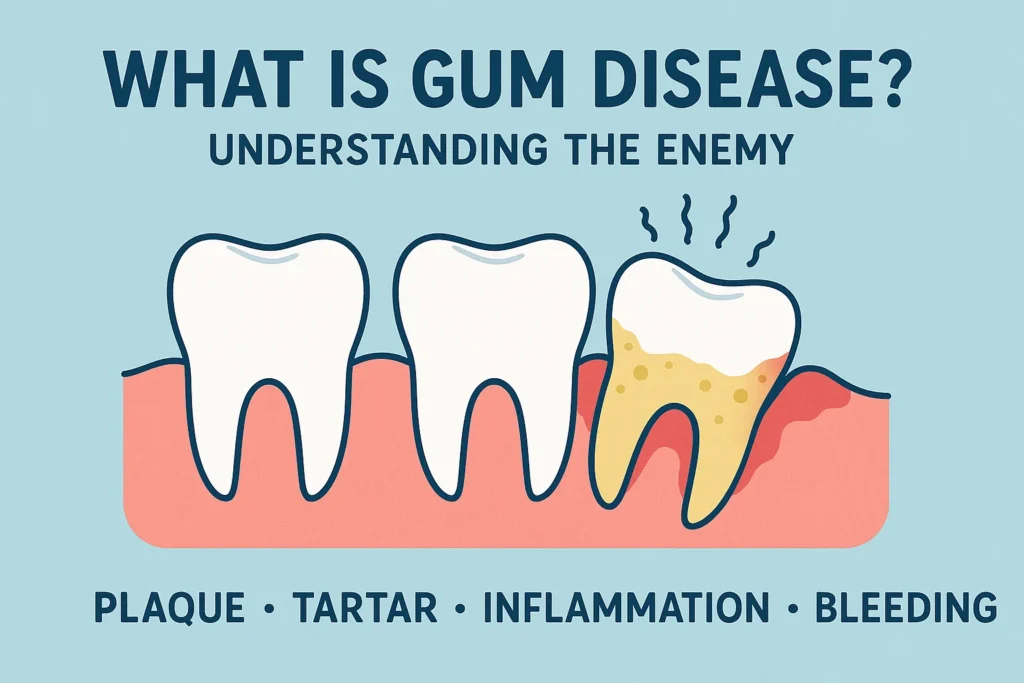
Periodontal disease, or gum disease, is a disease that is an inflammatory disease which is caused by tissues surrounding and supporting your teeth. It is mostly brought about by plaque, a sticky and bacteria laden grease that constantly develops on our teeth. Unless the plaque is eliminated successfully with the help of brushing and flossing, it becomes hardened into tartar (calculus), which can only be eliminated based on a dental professional.
The Two Key Stages: Gingivitis vs. Periodontitis
It is important to understand the distinction between these two stages as this gives you a window of opportunity in which you can turn things around.
- Gingivitis: This is the first stage of gum disease and it is reversible. The gums (gingiva) is limited in its inflammation. No irreversible damage to the connective tissue or bone has taken place. It is the step when it is most important to identify the first symptoms of gum disease.
- Periodontitis: In case gingivitis is not treated, it progresses to periodontitis. In this case, the inner gum layer and the bone will draw away in the teeth and form pockets that will be infected. The immune system of the body combats the bacteria, however, the enzymes and toxins generated in the combat begin to weaken the bone and connective tissue which keep teeth in place. This is something that can never be reversed but can be controlled.
The 4 Most Common Early Signs of Gum Disease You Can’t Ignore
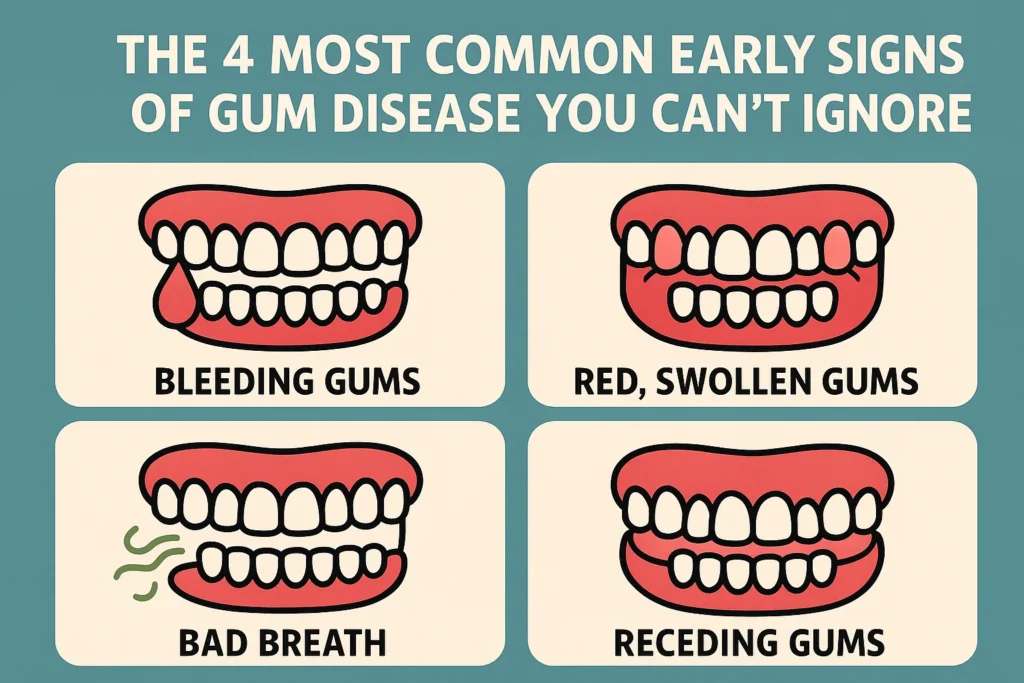
Your body sends clear signals when something is wrong. Here are the primary warning signs of gum disease to watch for every day.
1. Bleeding Gums: The Cardinal Symptom
What it feels/looks like: You can see a pink or red stain on your bristles of the toothbrush, in your saliva after brushing or on the floss. It can be daily or even once in a week. Another myth is that bleeding gums are as a result of brushing hard. Although that may be a reason, healthy gums do not bleed when one cleans them properly and not harshly.
How it occurs: The accumulation of bacteria plaque irritates the gum tissue, which results in inflammation (gingivitis). This inflamed tissue is weaker and experiences high blood flow and thus bleeds easily when in contact.
Pro Tip: When your gums are bleeding that does not mean that you should stop cleaning them. It is an indication that you must do a better job and work on cleaning that part more regularly to get the plaque that is leading to the inflammation. In case the bleeding continues after a week of good oral hygiene, visit your dentist.
2. Red, Swollen, or Tender Gums
Feel/appearance: Healthy gums are solid and coral pink (or colored to the color of your skin). However, inflamed gums will turn red or purplish, puffy or swollen and sometimes tender or sore to touch.
The cause: The normal response of the body to irritation and infection is inflammation. The redness and swelling are brought about by the augmented blood circulation to the region to combat bacteria.
3. Bad Breath (Halitosis) or a Persistent Bad Taste
What it looks/feels like: Your mouth has a foul smell or you have a foul taste that cannot be removed even with the help of a brush, floss and mouthwash.
Why it occurs: Bacteria that cause gum disease emit volatile sulfur compounds (VSCs) the same compounds that make rotten eggs smell. These bacteria live in the accumulation of plaque and in the areas between your teeth and your gums and result in chronic bad breath.
4. Gum Recession or “Longer Looking” Teeth
What it feels/looks like: You may find that your teeth are longer than they were before or you may be able to feel a notch close to the gum line. This is due to the fact that the gum tissue is withdrawn away.
Why it occurs: With continued inflammation, it may destroy the gum tissue and the bone that holds the teeth creating recession of the gums. Gingivitis One of the indicators of the progression of gingivitis to periodontitis is the recession.
Veneers vs Dental Bonding: Which Is Right for Your Teeth?
Visual Guide: Early Signs of Gum Disease Pictures
One thing is to read about the symptoms, another to be able to see them. The difference between healthy and unhealthy gums is as compared below, so that you can imagine the difference. (Note: A dental professional must always be consulted in order to make a conclusive diagnosis.)
| Healthy Gums | Early Signs of Gum Disease (Gingivitis) |
|---|---|
| Firm, coral pink or pigmented to match skin tone | Red, swollen, and puffy appearance |
| Snug fit around the teeth | Gums that are pulling away, making teeth look long |
| No bleeding during brushing or flossing | Bleeding easily during routine cleaning |
| No persistent bad breath or bad taste | Chronic halitosis or a metallic taste in the mouth |
What Causes Early Gum Disease? Risk Factors to Consider
While plaque is the primary cause, several factors can significantly increase your risk of developing the initial signs of gum disease.
- Poor Oral Hygiene: The first contributor is inconsistent/ineffective brushing and flossing.
- Smoking and Tobacco Use: Early smoking-related gum disease may be impossible to detect since nicotine causes the blood vessels to constricted blood flow to the gums to reduce any detectable bleeding. But, smoking is among the major risk-takers to the onset and advancement of gum disease.
- Hormonal Modifications: Puberty, pregnancy, menstruation and menopause may cause the tendency of gums to become sensitive, prone to gingivitis.
- Drugs: There are drugs that suppress the flow of saliva (that has a protective effect) or lead to abnormal growth of the gum tissue.
- Genetic Predisposition: Your family history of gum disease may put you at risk.
- Systemic Diseases: It can involve such diseases as diabetes, cancer, and HIV/AIDS that may disrupt the functions of the body to combat infection, even in the gums.
Early Signs of Gum Disease Treatment: How to Reverse Gingivitis
The most empowering information regarding early-stage gum disease is that there is a reversal of gingivitis. The following 5-step action plan can be taken in case you observe the two initial symptoms of gum disease such as bleeding and redness.
Step 1: Book Professional Dental Cleaning.
This is non-negotiable. A hygienist is able to remove the hard tartrar (calculus) which you are unable to do at home. This gets rid of the irritant that is always causing an irritation to your gums.
Step 2: Brush Your Teeth the Best.
Clean teeth with soft-bristled toothbrush twice a day and in two minutes. With the brush hold at 45 degrees with the gum line and make soft circular strokes. Vigorous brushing might harm the gums and the enamel.
Step 3: Flossing should be an Everyday Practice.
Flossing is not optional. It gets between teeth cleaning the teeth where the toothbrush does not reach. In case you are not comfortable with the conventional floss, use floss picks, water flosser, or interdental brushes.
Step 4: Take into account an Antimicrobial Mouthwash.
A therapeutic over-the-counter mouthwash will be useful in reducing the levels of plaque and washing away the remaining debris. Search such ingredients as essential Oils or cetylpyridinium chloride. It should be remembered that the mouthwash is a supplement to, rather than a substitute of brushing and flossing.
Step 5: Mitigate Risk Underlying Factors.
Cessation of smoking, treatment of chronic diseases such as diabetes, and a healthy diet. Good health contributes to good health of the mouth.
When to See a Dentist: Don’t Wait Until It Hurts
The pains of gum diseases are normally characterized in the early stages. Always be a sufferer when you anticipate. You should schedule a visit with the dentist or periodontist immediately when you notice:
- Gums that are easily irritated to brush or floss.
- Bad breath or bad taste in the mouth does not disappear.
- Red swollen tender gums.
- Wagging teeth or change of your bite.
- Presence of pus in between the teeth and the gums.
FAQ: Your Questions About Early Gum Disease, Answered
What are the two early signs of gum disease?
The bleeding gums (vomitantly during brushing or flossing) and the red swollen gums are the two most frequent and the most indicative initial signs. When you observe either of these then it is time to step up the effort in your oral hygiene and visit your dentist.
Is it possible to reverse early gum disease?
Yes, absolutely. The initial phase, that of gingivitis, is fully reversible upon professional dental cleaning and regular and excellent oral hygiene at home.
What does periodontal disease at an early stage appear like?
Gingivitis (early gum disease) usually appears as red, swollen and inflamed gums rather than hard, pink gums of color. It is also possible to find a pink stain of your toothbrush or floss with bleeding.
What is the duration of reversal of gingivitis?
With an oral care and professional cleaning at home (brushing your teeth properly and brushing your gums with floss), you can also notice the great improvement within two-three weeks. The bleeding is to be stopped; the redness and swelling are to be healthier.
Do dogs or cats exhibit the symptoms of gum disease at an early stage?
The answer to this is yes, pets are also prone to gum disease. The disease in dogs and cats early on has the same signs and symptoms as in humans; bad breath, swollen or red gums, bleeding, difficulty eating, and pawing at the mouth. They need to undergo regular veterinary dental check-ups.
What will be the outcome of disregarding the initial symptoms?
Lack of attention to gingivitis also leads to periodontitis which kills the bone holding your teeth. This may cause irreparable damage, loosening of teeth and at last loss of teeth. It also has been associated with systemic health problems such as heart disease and diabetes complications.
Conclusion: Your Smile’s Health is in Your Hands
Recognizing the early signs of gum disease is your first and most powerful line of defense. Symptoms like bleeding, redness, and bad breath are not normal—they are your body’s distress signals. By taking these signs seriously, committing to a thorough daily oral hygiene routine, and maintaining regular professional cleanings, you can reverse gingivitis and protect your smile for a lifetime. Your oral health is inextricably linked to your overall well-being. The power to preserve it starts with the knowledge you now possess.
Ready to take the next step? If you’ve recognized any of these symptoms in yourself, don’t delay. Schedule an appointment with our dental team today for a comprehensive evaluation and personalized care plan. For more information on maintaining optimal oral health, read our complete guide to oral hygiene here.
